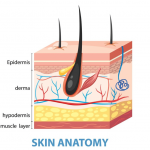Hair Transplants for Sideburn Restoration
Sideburns are the strips of facial hair that grow along the sides of your face, extending from the hairline above your ears to just below them. This classic facial hair style gets its name from Ambrose Burnside, an American Civil War general who made the look famous in the late 19th century. Originally called “burnsides,” the term eventually evolved into “sideburns.” You might also hear sideburns called “sideboards” or “side whiskers.
Both men and women can naturally have sideburns; however, the thickness and prominence of these hairstyles might differ. Men’s sideburns extending past their chins are called beards, not sideburns. Uneven sideburns should also be avoided, as they might distract from the style of your beard.
You might attempt the following techniques to get rid of sideburns:
- Bleaching: Lightens the hair to minimize its visibility.
- Hair removal cream: dissolves hair to the point at or slightly beneath the skin’s surface.
- Electrolysis: A tiny probe involves zapping the hair follicle with heat or chemical energy.
If, of course, you don’t want facial hair, then it may be fantastic for a variety of purposes, such as a creative outlet or framing your distinctive characteristics. The undesired hair thus becomes a continual annoyance, and any associated advantages are rendered meaningless. However, when it comes to coarse hair extending down the side of your face, things get much more complicated. Sure, shaving off an errant eyebrow or two isn’t that horrible. If you’re looking for a flawless cosmetics application or a smooth, fuzz-free skin, let’s be clear: sideburns and other facial hair are normal and wholly natural but bothersome.
We thus have the solution for you if you are facing an ongoing fight with hair growth.
- Put the razor away: “For women, no, but if you’re a male, sure! Our skin is far more delicate,” Shays claims. Shaving may irritate your face’s delicate skin, resulting in pimples or ingrown hairs. Additionally, it doesn’t eliminate hair from the root, so you might have to maintain shaving often to prevent your hair from growing into a five o’clock shadow. Frank advises against shaving your sideburns since it might also result in an annoyance-causing, uniform stubble.
- Snatch up the bleach: You may even bleach it if you’d rather not deal with hair removal. Bleaching will lighten sideburns, reducing their visibility. However, ensure the bleach you’re using is designed for facial hair since other hair bleaches may be excessively abrasive and cause skin irritation or burning.
- Utilize a cream for hair removal: Try utilizing a hair removal cream for an at-home treatment that lasts longer. To eliminate hair, apply the product to the desired region and let it work for ten to fifteen minutes. The hair removal cream works by dissolving the hair to a depth either at or slightly below the surface of your skin. Results may not show up for several days, depending on how quickly your hair grows. However, Frank notes that these solutions are most effective on thin hair, so it can be more challenging if your hair is coarser or thicker.
- A Thread for an Instant Repair: Consider threading to remove hair from the root rather than tweezing. Though the outcomes are similar, threading is a beautiful way to remove sideburns and other more extensive regions of unsightly facial hair since it can remove many hairs simultaneously instead of requiring you to grasp each separately. If waxing is too sensitive for your face, this method is an excellent substitute since it pulls hair using a fine cotton thread. Like waxing and tweezing, once the follicle is destroyed over time, your hair may come back finer and less apparent. Furthermore, it usually lasts for a few weeks.
- Consider waxing: Shays points out that waxing the sideburns leaves you with a clean appearance that facilitates even makeup application and eliminates the need to deal with stubble or tweezing marks. Furthermore, when the hair is removed at the root, it can eventually grow finer. Shays said that depending on how quickly or thickly a person’s hair returns, she usually sees them for a wax every four to ten weeks. She suggests bathing with an acne cleanser 24 hours after getting waxed if you have oilier skin to prevent a breakout.
- Think about getting rid of hair with laser: You can visit a laser hair removal professional if you want longer sideburn support. You guessed it—a laser is used in this procedure to harm hair follicles and stop hair from returning. According to Frank, a laser hair removal specialist, there is no other effective method for permanently eliminating hair. “Laser hair removal is great for all skin types and can permanently remove the hair in three to four monthly treatments,” he says.
Hair restoration to the sides of the face, in front of the ears, can be achieved surgically with a sideburn hair transplant. If your sideburns have thinned or disappeared because of hormones, surgery, trauma, or heredity, this technique can help. Moreover, following a facelift may replace lost sideburn hair or create attractive facial hair symmetry.
Hair grows best on the back of the head, so the surgeon cuts a strip of scalp skin during the treatment. Hair follicles are then removed from the individual grafts made from the scalp. The surgeon then transplants the hair follicles into the sideburn region, making tiny incisions to place the grafts.
Ensure the donor hair’s thickness, tissue, and color match the sideburn for a natural-looking outcome. The surgeon should closely observe the direction and angle of the grafts’ hair growth pattern.
The recipient region is numbed with anesthesia and shaved following the surgery. Eventually, the transplanted hair will start sprouting and continue to grow.
What is the DHI Hair Transplant Procedure?
DIRECT HAIR IMPLANTATION (DHI) – DHI is a unique hair transplant procedure which can only be performed by:
- DHI Technique
- DHI certified doctors
- DHI protocols
- DHI’s patented instruments
- At DHI-authorized clinics
No pain, no scars, no downtime. The perfect natural result every single time.
Why choose a hair transplant treatment at the DHI clinic?
DHI technique and its benefits are propriety to DHI Medical Group. Some clinics and doctors try to copy this and claim to use the DHI technique, which is misleading. The following features are only available at DHI-authorised clinics.
1) We are proud to be ranked #1 on customer satisfaction in a hair transplant industry survey by IMRB. Our customer satisfaction rate is more than 99%. Also, they received the Customer Excellence Award from Quantic and numerous other awards & accreditations from medical bodies worldwide.
2) Our results are not just good; they are fantastic! Click LINK to see our results and LINK to get our customer feedback.
3) We provide hair restoration services for men and women with all stages of hair loss. This includes high growth factor PRP/GFC therapies and Activa Regenera treatment for early-stage alopecia, hair transplants for all stages of alopecia, and the highest-quality natural human hair cosmetic patches for very advanced stages of alopecia. Our hair loss treatment products and nutraceuticals have the highest-grade active ingredients, and you can shop for them here.
4) All procedures are performed from start to finish by DHI doctors trained and certified by the London Hair Restoration Academy. The surgeons are focused only on hair restoration procedures. Every procedure undergoes strict quality control.
5) All procedures are performed per strict standard operating protocols accredited with the UK Care Quality Commission and ISO standards.
6) The world’s safest hair transplant procedure is performed in a sterile environment according to comprehensive safety protocols. All procedures are performed only after proper diagnosis and medical tests.
7) Our patented implanter allows Perfect control over angle, depth, and direction. Only the highest-quality imported instruments are used and discarded after every procedure.
8) One-step implantation to ensure minimal graft handling. The highest graft survival rate is over 90%, compared to 50-90% in other clinics.
9) There are no stitches, pain, scarring, or downtime. You can return to work the next day. It is just a short procedure to regrow your hair naturally and permanently. Daily Mail UK titled DHI the “Lunch Hour Transplant” (click here to read the article).
10) Achieve strong density in a session compared to other low-density techniques such as FUE and FUT.
11) Natural Results Guaranteed – The DHI technique gives you a perfectly natural result; others will only know you had a transplant if you tell them.
12) DHI is the world’s largest hair restoration medical group from Greece. For more than 50 years, we have focused on research, innovation, and education in hair restoration. We have 75 clinics in 45 countries serving more than 5,00,000 satisfied customers. Top celebrities from the entertainment, sports, business, and politics only trust DHI for their hair restoration.
7 Key questions you should ask before choosing your hair loss solution
- Who will perform the procedure?
In most clinics, procedures are performed by technicians only. The clinic owners are plastic surgeons and dermatologists, mainly involved in sales and marketing. Their involvement in the actual procedure is minimal. It would help if you went to a clinic where a doctor performs the entire procedure, not through a technician.
It is also important to check if the clinic or doctor specializes in hair transplants or offers other aesthetic treatments, such as Botox. A better choice would be to go for a super specialist doctor.
- Is your doctor suitably trained and certified? Do they follow standard and accredited protocols?
Doctors often learn about hair transplants from other doctors without any evaluation or certification process. It can take years for them to understand the intricacies of hair transplants. Further, most doctors do not follow written protocols and perform procedures based on personal preferences, leading to sub-optimal results.
Please check if the doctor performing the procedure has training and accreditation from a reputed institute. Very importantly, personally verify if the clinic has written protocols for all stages of the hair transplant procedure, including detailed safety protocols.
- What is the experience of the clinic/doctor you are going to?
Hair transplants are a relatively new area of practice, which has lured many doctors to leave their practice in the field of their expertise and move towards hair transplants only in the last 3-5 years. Many clinics may not have the experience, protocols, or necessary expertise to handle hair transplant cases. Please ensure that the clinic has been established for many years and has a verifiable reputation. Do not just rely on what they claim.
- How does the clinic ensure the quality of your results?
Research shows that, on average, only half of the implanted hair may grow in specific clinics without proper experience. The clinic may not have access to the latest techniques, instruments, tools, protocols, etc. Please avoid freelancers working in many clinics on a case-by-case basis. They will likely spoil your case as they may care least for the patient. Sometimes, the doctor may be very qualified or experienced but past his prime to be able to give good results.
Do check if the doctor’s work is supervised by someone. Does the doctor follow any certification, assessment, and quality monitoring process? It is not advised to go to a clinic where there is only one doctor whose work goes unsupervised.
Proper technique, instruments, tools, protocols, training, assessment, and quality control are essential for good results.
- How do you ensure your safety during and after the hair transplant procedure?
Generally, hair transplants are safe and cannot lead to severe risks. However, sometimes scalp infections or even more severe conditions could occur if the correct safety protocols are not followed. This risk is very high when technicians or inexperienced doctors perform the procedure.
You are advised to ask relevant questions and follow the written safety protocols at the clinic.
Please see the procedure room and ask yourself if you feel confident about the safety protocols.
- Would you go for a hair transplant without a proper evaluation of your alopecia?
The answer is obviously No. There are ten kinds of alopecia. The correct treatment cannot be recommended unless a proper diagnosis is carried out. Many clinics recommend hair transplants without making a proper diagnosis. They also may not conduct a mathematical count of the donor and recipient areas to assess the hair transplant requirement and feasibility correctly. Please invest time and effort during your diagnosis and evaluate the doctor on proper dermatological examination diagnosis, precise donor and recipient area hair count, and computerized alopecia test. This results in a comprehensive lifetime treatment plan and the best results for your hair loss problem.
- Should price play a role in choosing a hair transplant clinic or doctor?
Yes, of course, price is indeed a very important criterion. But you should not choose a clinic or doctor purely on the cost. Many doctors can reduce their costs significantly by reusing the instruments, compromising on safety standards, using technicians to do the procedures, etc. Quality and Safety come at a price. This is your investment in your safety and great-looking results for life. So, choose wisely.






